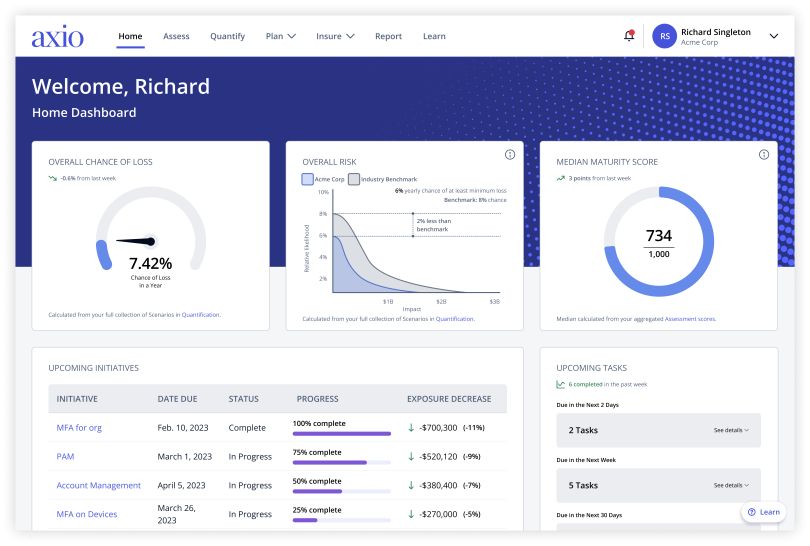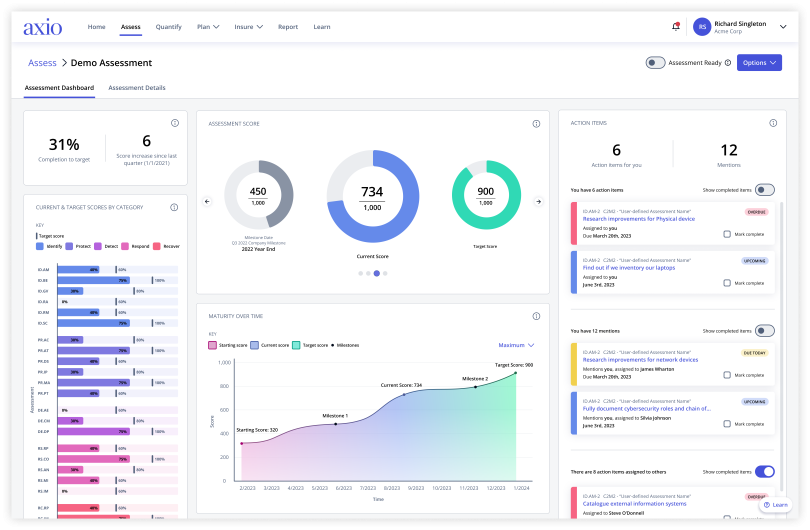While sitting in a New York City pub, Axio founders Scott Kannry and David White talked over the challenges facing chief information security officers in their roles each day.
Despite the increasing adoption of cybersecurity controls, the frequency of cyber attacks remained unabated, and CISOs spent valuable time and energy communicating the fundamental business risk presented by cyber threats.
Kannry and White had a vision for how to support CISOs in their work — and that vision took shape as Axio.
The founders aimed to provide CISOs with the necessary tools to communicate security improvements in a language understandable to a wider audience, fostering a more comprehensive understanding of cybersecurity across the organization.
“Our ultimate objective is to empower CISOs, enabling them to strategically plan programs that address the most critical risks,” Chief Product Officer Nicole Sundin explained.
In order to best serve CISOs and their business needs, Sundin stressed the importance of maintaining a collective focus on strategy and customer value. Rather than getting stuck in the weeds of addressing peripheral tech questions, a shared obsession with solving customer problems kept the team aligned along the road to launch.
Sundin has been instrumental in influencing the product strategy and overseeing the continued development of Axio360, the company’s cybersecurity platform, in collaboration with several cross-functional departments. Serving as vice president of UX and product management initially and later as chief product officer, she has consistently guided the execution process. Sundin has placed a strong emphasis on a design-first philosophy and prioritized user experience throughout her tenure, contributing to the continuous refinement and evolution of the platform.
As the cybersecurity landscape continues to evolve, Axio’s commitment to innovation, collaboration and user-centric design offers a fresh vision for how the cybersecurity industry can reshape the response to threats and provide effective solutions for businesses across industries.
Built In sat down with Sundin to learn more about how the team has played a pivotal role in refining and growing Axio360.

We strategically enhanced efficiency and productivity with our choices regarding tools and technology. For design, we employed Figma, and for user testing, we utilized Figma Prototypes paired with a mixed-methods script.
In terms of development technology, our core stack included React, Next, Typescript and GQL. We leveraged libraries such as Mantine, Tailwind CSS and Nivo for visualizations. Our testing framework comprised Jest, Cypress and React Testing Library. The build process was facilitated by Vite + Turbo with Docker for containerization. These choices were carefully made to align with the project’s requirements, ensuring optimal development workflows and scalability for future enhancements.
What differentiates Axio when it comes to how you build and launch new products?
There are a few key distinctions that set us apart from other security platforms.
We operate solely as a SaaS platform, foregoing an on-premises solution. This exclusive focus provides us with unparalleled flexibility in our release cadence, enabling us to promptly address customer requests. Our commitment to delivering value swiftly is a cornerstone of what makes us an exceptional company.
Differentiating ourselves as a design-first organization, we prioritize user experience and design in every aspect of our offering. By leading with thoughtful UX and design principles, we provide a distinctive and exceptionally valuable experience for our customers. This emphasis spans from user flows and visualizations to the construction of APIs, ensuring that our users encounter usable and delightful experiences throughout their interaction with our platform.
“By leading with thoughtful UX and design principles, we provide a distinctive and exceptionally valuable experience for our customers.”

What obstacles did you encounter in building Axio360?
Early and continuous emphasis on strategy and business value is paramount in navigating the complexities of large projects. It is crucial to instill a collective obsession with the strategy, which inherently revolves around solving customer problems. This shared focus prevents individuals from losing sight of the pivotal features that deliver real value to our customers.
When we encountered challenges where team members veered into exploring intricate problems at the expense of execution, our response was grounded in a team mentality. To maintain alignment, we consistently guided everyone back to the overarching vision. This ensured that the team stayed on course and prioritized the most impactful aspects that contributed to customer value.
What teams did you collaborate with in order to get this across the finish line?
We worked closely with multiple stakeholders, including product, UX, engineering, subject matter experts and, significantly, our customers. We prioritized customer and SME insights as invaluable sources of knowledge. Understanding the problems we aimed to solve was crucial, and tapping into customer expertise was imperative in shaping our approach.
A seamless collaboration among UX, product and engineering teams was essential in translating the thoughts and ideas uncovered through research with SMEs and customers into actionable implementations. This ensured that the entire process, from ideation to execution, flowed cohesively.







